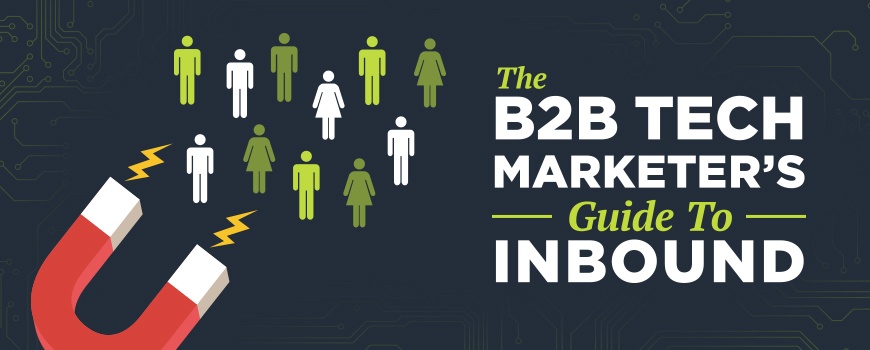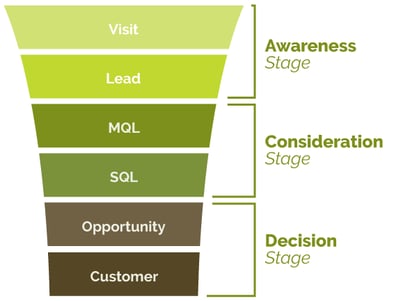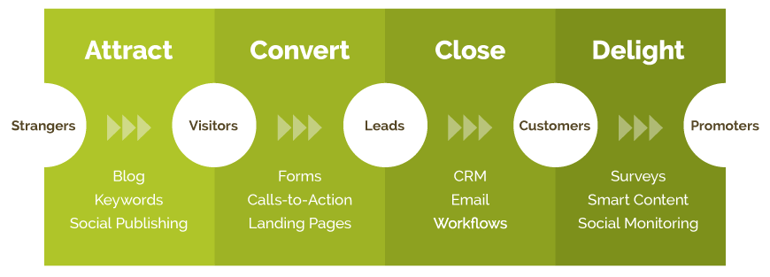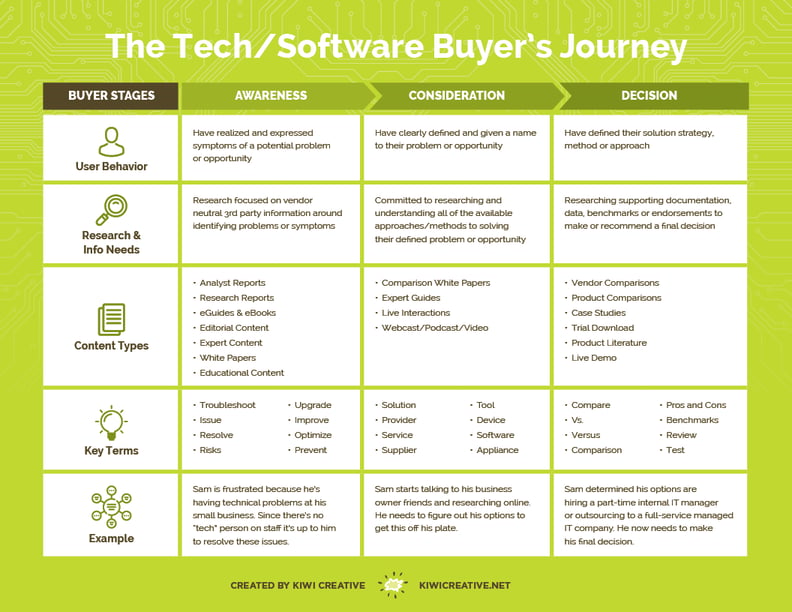
Hey savvy tech marketers…have you dreamed of a place where you can access all the tips and tools you need to execute successful inbound marketing? Well, look no further! Our small but mighty team of marketing strategists have put together this guide (and more!) to help you kick off your inbound initiatives.
The easiest way to explain inbound marketing is to start with what it’s not.
Inbound marketing doesn’t use traditional, unsolicited tactics, like TV commercials, direct (ahem, junk) mail or cold calling. Those methods are considered “outbound” because they focus on pushing your message out to people…who probably aren’t interested in hearing it.
By contrast, inbound marketing focuses on bringing people to you by offering content that is truly valuable to your customer. Valuable content can take many forms: an entertaining Twitter account, an email newsletter full of tips n’ tricks or an informative business blog, especially since marketers who blog are 13x more likely to see positive ROI. These are all things that prospects (and even current customers!) will voluntarily sign up to receive because they’re helpful. Of course the end goal is a sale, but the messaging focuses on solving a problem, not selling a product.

Think of it this way…
Do you remember the last time you considered making a big purchase—a car, an appliance or maybe a new piece of technology? Did you run to the store right away to talk to the nearest salesperson? Or did you take the time to compare prices, read customer reviews and then talk with a salesperson when you were ready to “test drive” the product or service?

We thought so.
Online buyers today go through more than half of the buying journey without ever talking to sales. So, inbound marketing is helpful to your customer because it’s made up of all of those “research” elements that are especially important when considering a hefty investment. It’s the valuable and helpful information you need to provide to attract strangers, convert visitors, close leads or delight your customers during their buyer’s journey. (More on this later.)
Speaking of customers…do you know who your ideal prospect is? As a smart tech marketer, we bet you already know some basic demographic information, like company size and job title. You probably also know that C-level execs tend to care most about ROI, whereas mid-level managers prioritize process improvement.

But beyond that, how much do you really understand about your customer's challenges, motivating factors and goals? And do you appreciate how important that insight really is to your business?
Demand Gen reports that a whopping 64% of B2B buyers chose providers based on a personalized buying experience. The top reason these vendors won was by demonstrating stronger knowledge of their buyer’s company and its needs!
Taking an educated guess at this information is a good first step, but it's easy to dig deeper. Interview your sales team to see what they’re hearing on an everyday basis. What questions are they constantly asked? Odds are, they’ll have tons of anecdotes about customer issues, buying objections and more. Even better, interview your best clients over the phone or via an online survey to get firsthand information.
Once you’ve done your research, compile all of the data into a buyer persona: a semi-fictional representation of your ideal customer. (And don't forget to add a cutsey, alliterated name, like IT Ian or C-Suite Charles!)

Once you're done, don't let this document live in a folder on your computer. Print out your buyer persona and hang it up at your desk. As a marketer, this tool will help you remember not only who you’re targeting, but also what type of content they’ll find useful at every stage of their buyer’s journey.
The path your prospect takes as they move down the sales funnel is called the buyer’s journey. It’s made up of three stages that the buyer goes through when making a purchase:

"I’m experiencing pain…what’s my real problem?”
“I know what the problem is…what are my options?
"I know the potential solutions…which one should I choose?”
While every buyer goes through these three stages, what customers do in each stage—and the length of time they “live” in each stage—is unique for every business.
For example, during the awareness stage, one company might attract visitors through blog posts whereas another could have great success on LinkedIn. During the decision stage, a SaaS company might find that downloading a trial works best whereas a cybersecurity company might close more deals through case studies or white papers.
By defining the actions your customer takes during each stage of the buyer’s journey, as well as how long the tend to “live” in each stage, you can use the inbound methodology to develop and distribute content that will help move them further (and faster!) down the sales funnel.
So how exactly do you move prospects through the buyer's journey—from awareness, to consideration, to decision? By using the inbound marketing methods to attract, convert, close and delight your customers.

If all this sounds great in theory, but you’re still confused about how to execute inbound marketing for your tech company in a real-life scenario, fret not…here’s an example of how the buyer persona, buyer’s journey and inbound methodology all work together. We’ll use a managed IT services company in this scenario.

Age: Late 40s
Job Title: Owner, Principal, CEO, Partner
Adjectives: entrepreneurial, visionary, impatient, delegator, conservative
Interests: running charity races, drinking craft beer, playing with his dog, DIY weekend projects
Pain Points: Technology breaks on a semi-regular basis (phone systems down, server misses a back up), causing him to waste time finding a band aid solution to keep operations flowing smoothly.
Primary Goal: To have a suite of technology solutions that “just work” to keep his business up and running.
Common Questions:
Your Company’s Competition:
Small Business Sam is frustrated because his printer isn’t connecting to the WiFi…for the third time this month. Since he doesn’t have a dedicated “tech” person on staff, he’s tried to fix it himself, but can’t figure out if it’s the internet connection or his laser printer. Sam is sick of wasting time running in circles. Oh, and his landline phone bill increased by 20% at the beginning of the year and he’s trying to control fixed monthly costs.
You want to attract Sam to your website where he can learn all about the benefits of a full-service managed IT company.
Sam has spent some time researching online, as well as talking to a couple other of his business owner friends. He’s realized he can no longer handle his growing IT needs himself. Sam needs to figure out what his options are to get these tasks off of his plate.
You want to convert Sam to a lead by getting him to opt-in to receive your stellar content.
How can you convert visitors to leads?
Why get him to take these actions, you might ask? Digitally speaking, email is currency. By collecting Sam’s email address in return for a piece of content, you now gain the opportunity to nurture him down the sales funnel through email marketing.
By now, Sam has narrowed down his options to either hiring a part-time internal IT manager or outsourcing to a full-serviced managed IT services company. He’s still deciding which will be the best option, from a service and cost perspective.
You want to close Sam and make him your customer!
Congrats…Sam has decided to become a retainer client of your managed IT services company!
As a marketer, you may think your work is done, but it’s really just beginning. B2B buyers trust word of mouth more than any other source of information. In fact, a reported 48% of B2B marketers get 50%+ of their business from brand advocates! (Fuggetta, Rob. Brand Advocates: Turning Enthusiastic Customers into a Powerful Marketing Force. Wiley, 2012. Print.) So, why not take your relationship a step further and turn Small Business Owner Sam into a brand promoter?
You want to delight Sam into becoming a promoter of your company.

How effective is your inbound marketing campaign at moving prospects through the buyer’s journey explained above? The only way to know is to measure results. Luckily, thanks to tools like Google Analytics, you can determine success (or failure!) virtually in real time.
![]() Page Visits: How many visitors viewed your content? If you launch new marketing efforts, you should expect to see a jump in page visits. Over time, this number should steadily increase. But remember…quantity doesn’t always mean quality!
Page Visits: How many visitors viewed your content? If you launch new marketing efforts, you should expect to see a jump in page visits. Over time, this number should steadily increase. But remember…quantity doesn’t always mean quality!
![]() Bounce Rate: Are people spending five minutes or five seconds on a web page? If your answer is less than a few seconds, they are likely not finding relevant content so it’s time to try a new message.
Bounce Rate: Are people spending five minutes or five seconds on a web page? If your answer is less than a few seconds, they are likely not finding relevant content so it’s time to try a new message.
![]() Leads Generated: Did the content convert any visitors to leads? If not, consider changing up your CTA. You want your visitors to be engaged, but you also want to pave a path for them to move seamlessly through their buyer’s journey.
Leads Generated: Did the content convert any visitors to leads? If not, consider changing up your CTA. You want your visitors to be engaged, but you also want to pave a path for them to move seamlessly through their buyer’s journey.
![]() Social Proof: Did anyone like, share or repost your content? Give your audience the tools to do the work for you. Place social “share” buttons on all content pages to expand opportunities for your content to be distributed.
Social Proof: Did anyone like, share or repost your content? Give your audience the tools to do the work for you. Place social “share” buttons on all content pages to expand opportunities for your content to be distributed.
![]() Inbound Links: Are any outside websites linking to your content? (This will help build your website's authority, a key SEO factor.) Build relationships with industry leaders and become active in relevant online communities where your customers hang out. Share their content and perhaps they’ll share yours.
Inbound Links: Are any outside websites linking to your content? (This will help build your website's authority, a key SEO factor.) Build relationships with industry leaders and become active in relevant online communities where your customers hang out. Share their content and perhaps they’ll share yours.
Even if your marketing seems to be working great, a smart tech marketer will ABT: always be tweaking! Be sure to follow this simple formula for continuous improvement: test, analyze, optimize, repeat.
If you’re still not sold on the idea of inbound marketing, here are some specific reasons it’s a perfect match for a software/tech company like yours:
Practice what you preach. If you’re trying to get people to invest in cybersecurity or move to the cloud, why are you still allocating so much money offline to print ads and direct mail? These methods can be used to supplement an inbound strategy, of course, but the majority of your efforts should be invested in digital tactics where you can focus on educating people who are already in the awareness stage of the buyer’s journey.
We live in a skippable world—caller ID, spam filters and streaming services like Netflix make it easier for customers to avoid cold calls and commercials. These old-school tactics push content in the face of potential customers whether they’re ready to buy…or not. Plus, businesses who focus primarily on inbound marketing experience a 61% cost-per-lead (CPL).
If you’re in tech, you probably appreciate the power of big data…and going digital with your marketing efforts gives you access to unprecedented user behavior insights. By using a powerful all-in-one marketing automation platform (like our favorite, HubSpot), you'll be able to see how individual users interact with your marketing—think page views, email opens and link clinks—then use this information to personalize future marketing outreach.
Tech can be overwhelming for novices. Your goal with inbound marketing is to make it easy to understand, positioning yourself as a clear expert in the field. Assuming you’re not selling purely on price, being seen as a trusted advisor will give you the clear edge during the decision stage of the buyer’s journey.
Inbound marketing is a long-term move. Sure, there are ways to get "quick wins"—like adding a lead flow pop-up to your website—but proving yourself as the industry expert to your customers (and Google!) takes time. The good news is that each and every piece of content you create adds value, and all of these build upon each other. A top-performing blog post could bring in leads months, if not years, after it was originally written. Can you say the same thing about a radio commercial?
Ready to get started with inbound marketing? Or looking to take your existing inbound efforts to the next level?
Kiwi Creative is a HubSpot Platinum Agency Partner that specializes in working with B2B software and technology customers. And, hopefully, after reading this web page, you can tell that we know our stuff.
We're a small, but talented, team of strategists, writers, designers, technologists and developers…all ready to help in-house marketing managers at tech companies with branding, website design, sales enablement and, of course, inbound marketing.
Want to chat about an upcoming project?